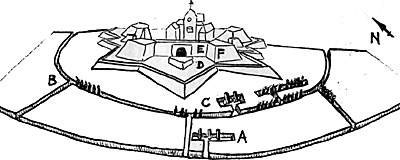 EDITOR'S NOTE: Bruce McFarlane of Alberta, Canada, President
of his local Wargaming, Moose Calling and Tundra Thumping Club,
wrote of an interesting amalgam of Barry Gray's siege game FESTUNG
KRIEG (FK) and our PW group's Seven Years War rules POUR LE MERITE
(PLM).
EDITOR'S NOTE: Bruce McFarlane of Alberta, Canada, President
of his local Wargaming, Moose Calling and Tundra Thumping Club,
wrote of an interesting amalgam of Barry Gray's siege game FESTUNG
KRIEG (FK) and our PW group's Seven Years War rules POUR LE MERITE
(PLM).
PLM (REVIEW, June 86), which we developed for our 30mm armies, had been modified by Bruce for his 15mm figures. The basic theme of PLM concerns morale... all impacts, both fire and melee, instead of resulting in figures being removed, will act as temporary negative modifiers to a unit's morale level. If the unit then fails its morale test, the morale grade goes down permanently. Four such failures and the unit is deemed disintegrated and is removed from the field.
Bruce, therefore, had to convert FK's "hit" tables to morale tables. Another interesting change concerned the amount of entrenchments thrown up by the besieging force. As its units took hits during the siege and had their morale levels lowered, the work the besieging units would do, i.e., entrenchments placed, decreased proportionately.
THE SIEGE OF FORTRESS 'FARLANE
Fortress 'Farlane is situated on a scenic green ping pong table, commanding absolutely nothing. As such, the site is ideally suited for recreational warfare. This particular siege involved the plucky but unlucky garrison, commanded by McFarlane the Timid, beset by the slimy and barbaric hordes of Vandersleen of Govonia.
First Week
Vandersleen's forces sapped forward on four different fronts. A long range siege gallery was established at Point A to intimidate the garrison, and because Vandersleen was bored of digging. Nothing much happened until the seventh day.
The besiegers had sapped too far forward without any infantry to protect the engineers in case of a sortie. McFarlane leapt (lept?) at the opportunity.
A night sortie consisting of 3 battalions (half the garrison) scurried over the covered way at B. Unfortunately, they did not achieve surprise, and so the engineers escaped capture. The sortie force then settled down to filling in the sap.
Three inches were filled in immediately... then the whole Govonian army showed up. One short musket volley, remove another 3 inches, and then race back to the walls and safety.
Here, the increment cards presented an interesting dilemma: how long do you wait before running? What if you draw "1's" and he draws "4's"? Anyway, I drew a 4 and a 3 to his pair of 1's and made it back easily. What strategy! What judgement!
Second Week
The saps pushed forward. My relief army did not arrive and a noose of parallels tightened on the fortress. Late in the week, things heated up.
Vandersleen had established a deadly mortar gallery right in front of Gate C. Although it was guarded by two battalions, I decided I would have to try to destroy the guns or lose the siege. Out went two battalions of infantry and one engineer battalion.
Again they were spotted before surprise was achieved. One musket volley was enough to scare off the gunners running the mortar battery, but a slugfest developed between the infantry forces as McFarlane's forces tried to buy time for the engineers to spike the guns. Meanwhile, the Govonian infantry had left the trenches on the wings and were closing in.
At the last possible moment, the defenders turned and ran for the safety of the walls. Things did not look good. But again lady- luck smiled with a 4 and a 3 card versus a 1 and a 2 card for the besieger. Result: one mortar battery spiked and four morale levels dropped for the Govonians, in exchange for 2 morale levels lost for the McFarlanites. Not a bad day's work.
The very next night, Vandersleen launched a storm on the main gate. His grenadiers got over the covered way, but ran home when they felt the effects of crossfire from the cannon on the battlements.
Vandersleen was heard to mumble: "I'll be back when my siege guns do a bit of work on these walls!"
Third Week
Vandersleen was true to his word. His three siege batteries hit home for five days with incredible accuracy.
The front ravelin and wall crumbled. The final touch was a charge, set by a miner working for the last 2 1/2 weeks under bastion F. Undetected, this little mole had penetrated the walls and set 30 dice worth of charges. The resulting blast not only destroyed the bastion, and dissolved two battalions, but also eliminated the east wall.
McFarlane the Timid accepted fate and asked for the honours of war. "Next time, I buy a counter-miner!", he muttered.
Back to PW Review September 1987 Table of Contents
Back to PW Review List of Issues
Back to MagWeb Master Magazine List
© Copyright 1987 Wally Simon
This article appears in MagWeb (Magazine Web) on the Internet World Wide Web.
Other articles from military history and related magazines are available at http://www.magweb.com